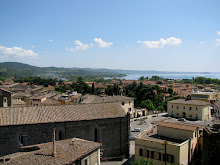We are What We Eat:
We define self by what we eat and do not eat.
Diaspora experiences.
In the Jewish experience, we see a kosher code, which defines what is "right food". Kosher law further provides a criteria for the selection of right food. The Jewish people stuck with kosher law no matter where they went. They define themselves by what they ate. They codified what is right to eat, and what is wrong to eat. These rules helped their culure and traditions remain coherent and viable.
The Greeks and Romans thought the urban was preferable to the wild. Saltus in Latin meant unproductive/uncivilized. Ager in Latin meant action result. This referred to the controlled land around the civitas, or the city.
The forest was where cultivated lands ended, and was fit only for the poor.The Roman and Greek diet focused on wheat, olives, grapes, cultivated vegetables and milk derivatives. A growing population in urban context, in the ancient world, created the question of how to use sustainable food systems to feed people.
In today's world, we have recently passed the marker of more people in urban settings then out of them.
Barbarians!
Confrontation
After the fall of the Roman empire, the value of European forest land was measured by the number of swine it could support. There was a decline in cultivated land. Meat became more important then bread, and meat consumption became a sign of power. The decline of urban areas meant less people, and the emergence of rural behavior in remaining urban areas. People began to keep animals like goats and pigs in urban regions. Less resources were invested in urban areas as well.
Meat became a bigger deal for European. People wanted to eat more meat then they used to, as a status symbol and a matter of fashion and taste. Meat, though, was not responding to the availability of resources. There were just not enough animals to answer the new need.
Moderation or Excess?
Greece and classical Rome valued moderation. Northern and barbarian populations meanwhile looked at vociferous eating as a sign of strength and the ability to fight.
An opposition existed between roasted meat and boiled meat. Christians and religious sects valued moderation and disliked brutal excess. They preferred domestication.
Aristocracy, meanwhile, preferred wilderness and hunting. The relationship between wild and civilized became interlaced from the III to VIII century. People used the forest and cultivated lands in tandem.
People began to use game reserves. There was a juxtaposition between raising pigs and hunting them. The forest becomes a resource, and is not outside or undesirable as in the Roman context.
Turning Point In European Food Systems:
Due to demographic pressures in the 10th century, monasteries promote agriculture, which causes deforestation. There is a choice between meat and cereals depending on population size. Demographic issues and weather conditions stressed food security in the X-XI century. An extension of agricultural land was the answer.
Acres of crops can support 20 people, and forest can support much less. Population increases, cereals become more important, available technology and output must be increased (cultivated land).
ACESS TO RESOURCES
As forests shrink, king and upper class come to control them, - monarchy in England and France, local potentates elsewhere (bishops, lords, abbeys, et all).
From IX century on cases of peasants opposing expropriation, mostly by abbeys then lay masters (XII- XII) Occasionally had success – use of small portion for hunting. Usually did NOT have success. Go figure.
Hunting in forest becomes an upper class privilege with fines attached.
From XI century on diet meat or vegetables connected not with culture but social class. Bread is stable, words “companaticum”.
Till XIII century not generalized by widespread wellbeing, but increase in agriculture + local markets.
Famine + abundance back in balance, vast majority of pop now has access to enough food by this time.
There is a revival of local markets so people can have more diverse diets.
LIMITS OF RESOURCES
Adaption of food system follows nutritional needs, over XIII century, a better balance is found. Cookbooks and gastronomy start to spread.
1270 marks hit of limit of available resources with available knowledge and technology.
New period of nutritional stress opens up, paving way to spread of pandemic, the bubonic plague of 1348. The population is reduced by 30-50%.
And Start of New Cycle
By the end of XIV and XV century, there is an abundance of meat. Increased proclamation of need of Lent and meat abstinence habits as Christian moral practice. Allowing fish also contributes to dissemnation of such.
Literary production on land of abundances – Bengodi, Coucagne. Growing culture of gastronomy and manners at table (XV century).
Abundance and Famine
Famine and Abundance
Two paradoxes: growth of food and food availability intersect on the planet of limits. The very poor don’t follow benefits of changing food systems, and stayed more steadily at same level of nutrition opportunities.
Tuesday, June 2, 2009
Subscribe to:
Post Comments (Atom)


No comments:
Post a Comment